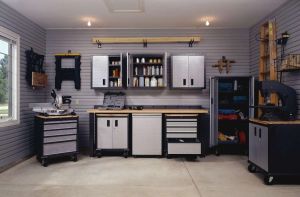Anatomy of a Garage
So what do you do if you decide you’d actually like to reclaim your garage for its intended purpose, which is a place to park your car?
If your garage is full of archival paper, broken items waiting to be fixed, remodeling supplies, toys and miscellaneous STUFF instead of your car, consider this question from Clean Sweep’s organizer Peter Walsh, “How much did your car cost? I’m guessing it’s one of your most costly possessions. So why are you keeping it out on the street, exposed to the elements? Sun, rain, and show do damage to your expensive car, yet your garage is protecting stuff that you likely seldom use. Does that make sense?” (179-180).
Why Garages Are Tricky
Peter Walsh names garages as “one of the most serious problem areas in a home, in part because it’s not even pretending to be a space where you try to live. It’s a real storage space, so everything with no place in the house gets shoved in there” (180). For anyone with a garage, even a relatively organized one, you know how true this statement is. It’s so easy to create piles of I-don’t-know-what-to-do-with-this in the corners and cabinets and on the shelves of garages, but when the stuff finally launches a coup and pushes the car out, it’s time to get serious!
The Process
The best process I know for reestablishing the garage as a workable storage space and a place to park your car is to use the Clear & SIMPLE Systems of organizing, developed by Marla Dee.
SEE IT
In order to make the organizing process easier and more fun, you have to know where you’re starting from. This essentially entails figuring out what’s working, what’s not working, where you’re stuck and why. Here are some examples:
• What’s working? We have a place to hang the broom, so at least we can find that!
• What’s not working? We have too much stuff! It’s taking over the space where we park the car and creating a safety hazard.
• Where am I stuck, and why? When I look in the garage, there’s so much stuff that I feel overwhelmed and I don’t know where to begin.
Here’s what a simple exercise like this reveals:
• If you had assigned places for items (like the broom) you would put them away in the same way you do the broom, so one of your goals will be to create assigned homes.
• You have overtaxed your space with more than you can reasonably store, so it’s time to purge!
• You may need some support either in the form of family, friends or an organizer to do this job because you’re overwhelmed. If you had known what to do with all the stuff, you would have already done something with it!
MAP IT
Tackling the garage can be a daunting task, so, as with any other large project, you need a good plan to ensure your success. MAP IT means Make A Plan. To create your plan, ask yourself these questions:
What’s my vision? (For example, I want to be able to park the car in the garage and find what I need when I need it.)
What purpose do I want the garage to serve? (You can ask this of everyone who might be affected by your organizing changes. Answers might include having room to store gardening items, seasonal decorations, tools, etc.)
What’s my time frame? (For a small, relatively uncluttered garage, count on at least 8 hours. For a very large garage like the one featured in this segment, plan on 60-70 man hours [including installation time]).
What are my budget considerations?
DO IT
You can remember the steps in the organizing process by the acronym S.T.A.C.K.S.:
Sort
Toss
Assign
Contain
Keep It Up
Simplify
Remember to do each step one at a time and IN ORDER.
Sort
In order to know what you have, you need to sort items into categories. Start with broad categories, like “Automotive,” and then sort into finer categories like “Engine Oil,” “Tow Ropes and Bungee Cords,” “Cleaning Supplies,” etc. I always use banker’s boxes (available at office supply stores and Costco) in order to keep items separate and contained during this stage.
I also create banker’s boxes for the following categories:
• Donate
• Toss
• Projects
• Somewhere Else
During the sort, your primary purpose is to simply determine which category an item fits into, but if you can decide in 2 seconds or less whether you wish to donate or throw items away, those decisions are permissible at this time as well. You will also likely discover uncompleted projects and items that live in some other room of the house. Keep these items in their respective boxes and return your “somewhere else” items to their homes at the end of your sorting session.
Toss
After your sort, go through each box to decide what to keep, donate or discard. BE RUTHLESS. Many organizers encourage letting go of 50% of the items currently stored in your garage. Even if you let go of only 20%, however, imagine how much extra space you’ll have! Use these guidelines if you get stuck:
• Ask, “Do I use and love this?”
• Ask, “Do I really have room for this?”
• Ask, “Can I store this somewhere else more suitable?”
• Toss anything you haven’t used in a year.
• Toss all mismatched and/or rusty screws and nails. Unless you have a lot of time to spend sorting these very small items, consider tossing them all and spending $25 at a home improvement store to get new ones. It will be time saved and money well-spent.
• Toss broken items you haven’t repaired in the past six months.
• Toss things that are component parts to items you no longer own.
Assign
In most garages, the single-most pesky problem is that items don’t have well-established homes. If you can’t always look for tools or gardening items or sports gear in the same place, you waste time, energy and money. You waste time and energy looking for misplaced items and money buying duplicates. Assigning is where you decide where your items will live. In organizer-speak, we call this “zoning,” and it is the single most important step in creating a workable garage. In the garage, good zoning means—
• Storing like items together so they’re not spread all over the garage.
• Storing items in order of accessibility so what you use most is most accessible.
• Using as much vertical space as possible to keep floors clear.
Standard garage zones include—
• Gardening
• Sporting equipment
• Seasonal deco
• Automotive supplies
• Paint and home repair
• Tools
• Garbage
When assigning these zones, make sure that the items you use most are the easiest to access. Starting at the entrance to the garage, place the items you use daily closest to the front, then follow with the items you use weekly, then monthly, quarterly, and then place seasonal or yearly-use items at the back. For example, if you bike several times per week, put your bikes right near the garage entrance. If you use your camping gear every week during the summer, create a camping zone behind the biking zone, and so on.
Also determine whether or not a zone has special requirements, like power sources or non-skid flooring. For example, your tool zone should be adequately lit and have plenty of outlets.
When you are creating your zones, be realistic about the amount of stuff you have in each category. If the items won’t fit, you have to decide whether you will expand your zone to accommodate them or whether you are willing to let more go.
Contain
In conjunction with effective zoning, containing helps you create a highly functional space. Note that containing comes after you have determined what you have to store and how accessible you need which items to be. It’s very easy to make costly mistakes by trying to contain too soon in the organizing process. Be sure you know what you have and where you want it to go before you contain— particularly if you are considering stationary shelving or built-in systems.
Before selecting containers, remember these rules of thumb:
• Measure EVERYTHING. Measure the piles you’ve sorted as well as the area where you wish to store things to make sure you have a good fit.
• Choose containers appropriate to the items you’re storing (e.g. no cardboard boxes for caustic chemicals).
• Choose the smallest containers you can so bins aren’t too heavy to move around.
• Place the lightest items on the highest shelves, where possible.
Some of my favorite garage containers are—
• Galvanized metal bins (available at Lowe’s).
• Large grid metal mesh bins (available at Lowe’s).
• Sturdy Rubbermaid containers (available at all big box retailers. Note: I love clear plastic containers for every other room of the house except for the garage. Because of a garage’s temperature extremes, clear plastic becomes very brittle and will break easily. If you want containers that you can see into, consider metal mesh bins.).
• Peg board and peg board accessory hooks (available at all home improvement warehouses. Lowe’s also carries plastic peg board.).
• Gladiator wall systems (This wall system, again available at Lowe’s, consists of tracking, hooks, shelving and baskets that can be customized to store virtually everything. The Gladiator wall system will also allow you to use your vertical wall space, which is underutilized in most garages. For a full view of Gladiator products and services, visit http://www.gladiatorgw.com/home.jsp).
•Overhead ceiling suspension systems (See http://www.hyloft.com/ for a sample. These products are also available in-store at Lowe’s.).
• Small bins or divided boxes for nails, screws, nuts, bolts, washers, etc.
•Industrial Velcro cord wraps (available at home improvement warehouses).
If your budget allows closed cabinets or stationary shelving, Lowe’s and other home improvement warehouses have ready-made systems available. Lowe’s Gladiator system has online access so you can create blueprints before you buy. If you hire someone to install a garage system for you, make sure he or she is willing to do a detailed plan before beginning work or is willing to build to your specifications.
Keep It Up
In the end, an organizing project is worthwhile only if you maintain it. To make maintenance easier, follow these guidelines:
• Label everything. Labeling is particularly important if you store in opaque containers. For bins containing many items, make a list of all the items, put the list in a sleeve protector, and affix it to the outside of the bin. You may opt to use a labeler. You can also create labels on your computer, have them laminated, and attach them with Velcro, double-sided tape or zip ties. Also label shelves so you know where to replace bins or items after you have used them. If you have open-bar metal shelving, label the wall behind where you store specific things. Doing this will help you maintain your zoning.
• Take time once a year to make a sweep of the garage and return out-of-place items to their homes. You can also take this time to do a quick toss on any items you no longer use or that are broken.
•Observe the “one in, one out” rule religiously. If you buy something new and have a like item, decide which one will stay and which will go. Who really needs five hammers?
Simplify
Simplifying is all about making conscious choices about what will, and will not, enter your space. If you have reclaimed your garage from chaos, be vigilant so your space stays clear and functional. When you have an itch to acquire something that will be stored in the garage, ask yourself—
• Do I need this?
• Will I use it?
• Do I have room for it?
If the answer to these questions is no, let it go. If the answer is yes, have fun shopping!
It’s a perfect time of year to launch a garage organizing project, so gear up! Imagine how nice it will be to climb into your car INSIDE your garage this summer and not burn your hands on the steering wheel or have your kids cry about how hot the leather seats are. Now there’s some motivation!
Happy Organizing!
Works Cited
Walsh, Peter. It’s All Too Much. New York: Free Press, 2007.
For more organizing tips contact Kelly Pratt at Spaces Limited Organizing (801) 386-1120.















Add comment